USWNT set for latest World Cup clash with Sweden in Round of 16
To paraphrase those Swedish poet laureates ABBA: Mamma mia, here we go again.
The United States and Sweden are set to renew one of the best rivalries in women’s soccer on Sunday morning in an unexpected Round of 16 showdown at the World Cup in Melbourne, Australia.
The U.S. Women’s National Team emerged from group play as Group E’s wobbly runners-up.
Their perch atop the sport appeared as perilous as ever, head coach Vlatko Andonovski looked ill equipped for the job and retired team great Carli Lloyd took potshots at the players for poor performances and, uh, signing autographs. Sweden, meanwhile, eased to first place in Group G.
The two world powers will be meeting for the sixth consecutive World Cup, and they also clashed at the past two Olympics — with explosive results.
“We always play Sweden in every major tournament,” U.S. forward Alex Morgan said this week. “Probably every time since I’ve been on this team. So, we know them very well. We know their strengths.”
What makes Sweden such a frequent and determined nemesis for the USWNT? Let’s take a look:

The history
The United States mostly has gotten the better of Sweden in their previous World Cup clashes.
There were group-stage wins in 1991, 2003, 2007 and 2019 (when Sweden appeared none too upset to be relegated to what was perceived as the weaker half of the knockout bracket — maybe there’s a lesson in that), a scoreless draw in 2015 and a Sweden group-stage win in 2011 (the USWNT recovered to reach the final).
Rather, it’s Sweden’s wins in the past two Olympic tournaments that provide the worries for American fans.
In 2016 in Rio de Janeiro, Sweden, led by former USWNT coach Pia Sundhage, bunkered in and eliminated the Americans in the quarterfinals on penalty kicks after a 1-1 draw, prompting an infamous outburst from goalkeeper Hope Solo.
“We lost to a bunch of cowards,” Solo said. “The better team did not win.
“They didn’t want to open play. They didn’t want to pass the ball. They didn’t want to play great soccer.”
In the opening match of the Tokyo Olympics in 2021, Sweden blitzed the U.S., 3-0, ending their 44-match unbeaten streak.

“It’s frustrating, and it’s frustrating that it’s Sweden,” U.S. forward Megan Rapinoe said at the time. “They found a lot of space on us.”
The Americans never looked quite right for the remainder of the tournament, stumbling their way to a bronze medal.
Sweden’s strengths
Sweden, entering the 2023 World Cup, was expected to have one of the best defenses in the field.
It lived up to that reputation in winning all three of its group-stage matches, culminating in a 2-0 victory Wednesday over Argentina in Hamilton, New Zealand, with several usual starters resting on the bench.
The Swedes scored a combined nine goals and conceded just one in the group stage.
Expected goals statistics — metrics designed to measure the probability of a shot resulting in a goal — portrayed a less favorable picture: Sweden posted a cumulative 7.7 expected goals (xG) and 2.4 expected goals against (xGA).
(Those same numbers for the sky-is-falling USWNT? 7.8 and 0.7. Hmm.)
Sweden relied heavily on set pieces in the opening round, scoring four of its goals off of corner kicks, including three near-identical headers by 5-foot-10 center back Amanda Ilestedt.
Sweden tends to operate out of a conventional 4-2-3-1 formation.
The dangerous Stina Blackstenius, who plays her club soccer at Arsenal, features at center forward.
She had two goals in Sweden’s rout of the USWNT in Tokyo.
Kosovare Asllani orchestrates the attack out of an attacking midfield role.
Fridolina Rolfo, who played last season with a juggernaut Barcelona team, scored two goals in the group stage from the winger position.
Sofia Jakobsson, who likely will come off the bench, plays in the NWSL for the San Diego Wave and is a teammate of both Morgan and American center back Naomi Girma.
There’s plenty of familiarity between these two teams. The question is: Will that result in the United States’ untimely demise or will it provide the foundation they need to get a foothold in this World Cup?


